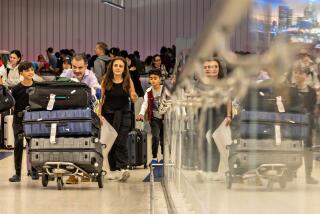Airport Unveils Faster, Safer Passenger Check
- Share via
LINTHICUM, Md. — The government unveiled Thursday its model airport passenger checkpoint, designed to prevent gridlock this summer as flights are expected to return to near-normal levels and security screening duties switch from private to federal employees.
The prototype, now operating at a concourse of the Baltimore-Washington International Airport, is better organized and more closely contained and controlled than a typical checkpoint, officials say. It features detectors that can’t be unplugged, special enclosures for passengers who require more scrutiny and electric gates that can be quickly closed if there is a security problem.
Hans Miller, a project manager for the Transportation Security Administration, the new federal agency charged with overseeing airport security, said the new approach offers measurable improvements in efficiency and weapon detection. The model will be phased in at other airports beginning this spring.
By summer, the transition to federal security screeners at 429 airports will be in full swing to meet a Nov. 19 deadline for deploying federal screeners. If security isn’t streamlined, industry analysts warn that summer travel could become a maddening experience.
“Prior to Sept. 11, there were runway bottlenecks. Now [the bottleneck] is security,” John Hansman, director of MIT’s air transportation center, said at a recent conference. “Delays to airplanes have gone down, but delays to passengers have gone way up. We have terminal evacuations competing with weather as a key unpredictable cause of delays.”
Since Oct. 30, there have been at least 156 concourse evacuations, according to Federal Aviation Administration statistics. Of those, 62 ordered by federal authorities delayed at least 1,520 flights.
Air traffic has now rebounded to about 90% of its pre-Sept. 11 levels. And delays, after remaining essentially flat all winter, increased about 40% from February to March.
TSA’s Miller said the agency believes it can reduce delays and improve security by paying close attention to the details. In designing the new checkpoint, planners first broke down the screening process into individual steps, then tried to reassemble them in a better framework.
A single, serpentine line approaching the checkpoint makes it easier to direct passengers to an open metal detector. Metal detectors and X-ray machines are being wired to an electric power source in the ceiling. That prevents them from being unplugged and triggering an evacuation, as has occurred at Los Angeles International and other airports. An express lane is available for flight crews, people in wheelchairs and families with big strollers. Flat-screen monitors display security tips to passengers in line to speed their processing.
The sensitive issue of “wanding” passengers became a special focus, Miller added. Passengers who set off a metal detector are scanned using a hand-held wand only by a screener of the same gender. The screening takes place in a glass enclosure next to the metal detectors and X-ray machines so the passenger can keep an eye on carry-on bags and other travelers will not be delayed. A station has been set up to X-ray passengers’ shoes.
Miller said the new setup reduced waiting time at the concourse checkpoint from more than 20 minutes to under 12. The checkpoint can handle 850 passengers an hour, compared with 500 previously. About 40% of the extra passenger capacity was attributed to the addition of a fifth security lane to the four that were already in place.
The time devoted to wanding has also been reduced, from about 3 1/2 minutes per passenger to an average of one minute.
Officials were less specific about improvements in security. “We believe this checkpoint is much stronger,” Miller said. “There have been a number of stops and arrests for knives and one for a gun.” He said TSA special agents evaluated the checkpoint and found it more secure. However, Miller would not say whether any independent agency had conducted tests.
Some airline industry officials said the new checkpoint design appears promising. However, Michael Wascom, a spokesman for the Air Transport Assn., said TSA still needs to move ahead with a “trusted traveler” program that would exempt passengers who agree to a background check from multiple levels of screening.
Consumer advocate David Stempler of the Air Travelers Assn. said that the prototype is an improvement but that separating passengers who must undergo wanding from their carry-on items is problematic.
The public is showing patience with the government’s efforts to revamp airport security, polls show. In a CBS poll taken in January, nearly 88% of travelers who said they had been delayed by new security measures felt the delays were necessary. Another CBS survey in February found that 89% of passengers would be willing to undergo more intrusive bag checks and searches.
More to Read
Sign up for Essential California
The most important California stories and recommendations in your inbox every morning.
You may occasionally receive promotional content from the Los Angeles Times.













